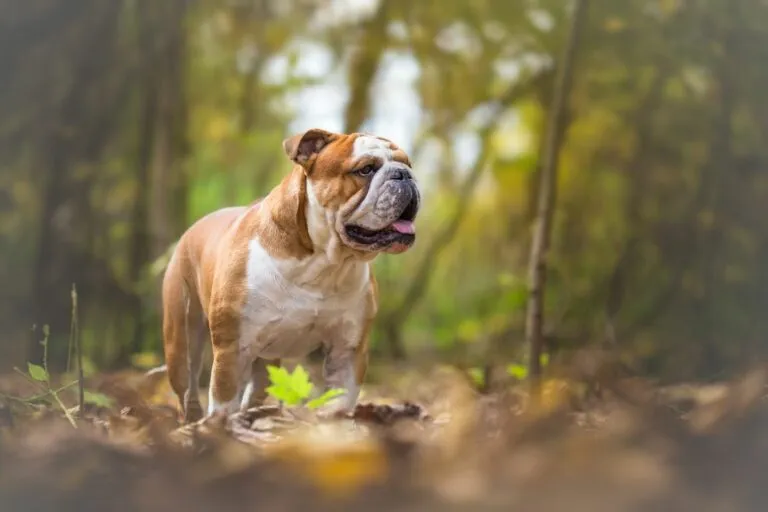Beagle
The Beagle's short legs can be deceiving – this medium-sized dog keeps you on your toes and is always full of surprises! This friendly breed is active, fearless and extremely clever.
The English Bulldog has a fierce look, is lazy and snores a lot – not quite the “dream companion” you'd imagine. However, with its distinctive charm, sense of humour and lovable, slightly clumsy nature, this dog breed wins hearts in the twinkling of an eye.

© Lunja / stock.adobe.com
As a matter of fact, this pedigree dog’s appearance doesn’t seem to fit with its character whatsoever. Its sturdy figure and discontented expression belie its friendly and sociable nature. When dealing with its family, the robust English Bulldog appears very tender, at times even sensitive. They are highly sensitive if their owner’s tone is harsh and can consequently behave in a most stubborn manner. Even though Bulldogs are extremely devoted dogs very much guided by their owners, they have maintained a certain sense of self-will. Commands given too harshly or that don’t make sense for the Bulldog can even just be ignored. The Austrian Bulldog Club reports that these dogs can be well trained if you take into consideration that they don’t think much of unconditional obedience.
However, if you’ve already won an English Bulldog’s heart and show it the way with consistent but loving training, it is easy to handle and proves well trainable despite its stubbornness. Thanks to its docile, tranquil nature, the Bulldog is now a popular family dog that can be taken everywhere – be it for dinner in a restaurant or an overnight stay at a hotel. Since bulldogs love children, they can thrive in a family with kids. Iit’s better if children are a bit older, because this strong and heavy dog can sometimes underestimate its tremendous strength. This can leading to involuntary clashes when frolicking around or playing. Nevertheless, it would never occur to a Bulldog to frolic around of its own accord, since English Bulldogs tend towards comfort. In contrast to Dalmatians or Border Collies, they are extremely unlikely to take the initiative and jump up in front of their owners to show they’re feeling active. Motivation and the art of persuasion is certainly necessary to tempt them out of their cosy bed.
It’s probably this very contradiction that makes the Bulldog’s nature so distinctive and lovable – a fierce and determined in its expression but docile and dependable in its behaviour. Lazy and phlegmatic, but at the same time active and full of passion if something has caught its attention.
 © Rita Kochmarjova / stock.adobe.com
© Rita Kochmarjova / stock.adobe.com
Barely any other dog breed has lived through such great change in the course of its history as the English Bulldog. Broadly speaking, once bred as aggressive “fighting machines” who courageously faced every battle, they are now kept as devoted, sensitive family dogs that detest violence.
The reason behind the emergence of this dog breed lies in the 6th century BC when the Phoenicians brought their Molossers to the British Isles for trade purposes. They crossed them with large mastiff dogs native to the area. Historically, the dogs are first mentioned under the name “bond dog” or “bold dog” in the 13th century. In 1209, these fearless dogs broke up fights between two warring bulls. Impressing with their bold nature and strong conduct, the intial dogs of this breed were soon regularly deployed as so-called “bull biters”. The struggle with the bulls made these powerful dogs very famous in the course of the Middle Ages. Hence, why they are called “Bulldog” to this very day. So-called bull baiting was a highly popular society event in Great Britain particularly from the 16th to 18th century, with large betting sums often involved.
In-demand dog fights against bulls were soon expanded into fights against other large animals, such as bears, monkeys or even lions. Pure dog fights involving two dogs fighting each other were also popular at this time. Bulldogs were considered pure fight dogs, with breeding focused solely on the characteristics that would serve them well in battle. Their nature was predominantly defined by courage and aggression. A wide jaw and nose withdrawn as far as possible to ensure sufficient air intake when biting bulls were highly valued.
When dog fights were banned in Great Britain by the government in 1835, the Bulldog was deprived of its breeding foundation. Consequently, the once popular fight dog disappeared from the scene almost entirely. This breed would probably have become extinct. However, individuals recognised the Bulldog’s adaptable and lovable character behind the cultivated “fight dog façade”.
In the mid-19th century, a new type of Bulldog breed came into existence, which was characterised by its friendliness and placidity and shunned its combative side and aggressive behaviour. In 1864, the newly founded Bulldog Club presented the first breed standard. This standard also held true for the Bulldog Club Incorporated founded in 1875, which defined English Bulldog breeding from that point onward. Thanks to their skilled breeding selection, the breeders succeeded in forging a well-tolerated and lovable family dog from the former fight dog. Adaptable and striking in appearance, Bulldogs soon became the Brits canine companion and eventually a kind of British national dog.
The subsequent breeding process unfortunately resulted in the dogs being extremely overbred. Over-typification such as incredibly large heads, too short noses and legs and extremely wrinkled faces led in some cases to so-called torture breeding. Along with respiratory and fertility problems, the extreme characteristics meant that it was no longer possible for bitches to give birth naturally. The proportion of Caesarean sections increased to over 80 percent.
In order to combat such extremities of torture breeding, the leading British Kennel Club lay down a new standard in 2009. Shockingly, this caused protests from many established breeders. Consequently, the dogs’ health and wellbeing is to be the main focus of breeding Bulldogs in the future. Fortunately, in October 2010, the FCI adopted this standard which is still in place to this day.
Nowadays the Bulldog is still characterised by a massive head with a short snout, a wide chest, narrow posterior and short legs. No characteristic should be so exaggeratedly pronounced that it impairs the dog’s mobility or makes it appear deformed. The stocky, compact body should be well proportioned. Although male dogs in particular are very heavy (approx. 25kg) in relation to their small size, their gait should not appear slow or laboured. The ideal English Bulldog is an active dog with no tendency to obesity. Dogs with noticeable difficulty in breathing are most undesirable according to the breed standard.
The Bulldog’s short, fine ears – known as “rose ears” – are set wide apart and high above the eyes. The tail is low-set on the typically narrow posterior, curving under at the end. An ingrown or “corkscrew” tail is now prohibited on the grounds of health problems.
The Bulldog’s short, fine fur can be found in whole or smut. Smut means the occurence of a black mask or muzzle. According to breed standard, accepted whole colours are white, brindles, reds, fawns, fallows. These should be pure or brilliant. Another variant is white with pied – i.e. white in combination with another colour. In contrast, black is considered undesirable (according to the breed standard, even though these dogs still are beautiful).
 © ltummy / stock.adobe.com
© ltummy / stock.adobe.com
The short, flat fur is very low-maintenance. Stroking the fur with a special dog glove from time to time is sufficient to keep it clean. However, the eyes and nose wrinkles require daily cleaning and care to avoid infectious diseases.
Furthermore, Bulldogs are very sensitive to heat, therefore long walks during hot periods should be avoided. It’s important for them to stay well hydrated and to have a shady area to which they can withdraw. In normal temperatures, one to two walks per day are suitable, one of which can be longer. Although Bulldogs appear somewhat lethargic, it’s important for them to have lots of activity and a well-balanced, healthy diet to prevent obesity, which can unfortunately often occur with this breed.
In addition, many Bulldogs still struggle with respiratory problems, finding it difficult to breathe and snoring excessively. Other typical illnesses are hip problems (HD), allergies, epilepsy and cherry eyes, a nictitating membrane disease.
Should you decide to acquire one, ask the breeder specific questions about possible breed-specific illnesses. Make sure that the new breed standards from 2009 are upheld. This is the only way to avoid high veterinary costs.
A Bulldog in good mental and physical health makes a very pleasant family and companion dog that feels just as comfortable living with one owner as with a big family. They love living with another Bulldog, but living in the same house as cats can lead to problems.
For this otherwise incredibly unassuming dog, love for its caregiver is the most important thing of all. An English Bulldog likes to be at the centre of things. No matter how big or small its family. If the dog is certain of this love, it makes a very calm and harmonious companion that. It also doesn’t appear to be affected by the hustle-and-bustle of big cities. Persuasion and discretion are key to make a Bulldog venture outdoors. In this sense, owners of the breed should be the opposite of their dog: only when they themselves make sport and activity fun will they manage to motivate their somewhat lazy pet to go for a longer walk or play outdoors, winning them round to the joys of physical activity.
The English Bulldog will certainly never be an enthusiastic participant in dog sports. This is because many breed specimens don’t take in enough air to the lungs. They also just don’t see much point in jumping over obstacles when you can just as easily walk around them. The owner will be confronted by the otherwise friendly Bulldog’s highly stubborn character in other situations too. Bulldog owners should have sufficient experience of handling dogs and also be assertive and consistent. In addition, having a certain sense of humour is recommended for a successful partnership with an English Bulldog. Compromise is also important, since total obedience cannot be expected from these dogs.
The Beagle's short legs can be deceiving – this medium-sized dog keeps you on your toes and is always full of surprises! This friendly breed is active, fearless and extremely clever.
The Golden Retriever is still one of the most popular dog breeds, especially with families. It is defined not just by its docility, but shows numerous other qualities too. Read in the following article everything you need to know about the Golden Retriever.
The German Shepherd is one of the most popular utility dog breeds in the world, though the willing-to-learn and people-focused nature of these versatile dogs also makes them suitable for family life.